 |
|
My
War Story Of Service In HMS Firedrake
By Dr John Aldren HMS Firedrake's Doctor May 1941 ~ November 1942. |
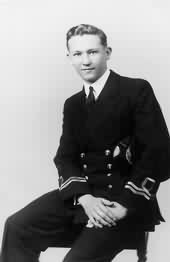 |
When World War II started in September 1939, I was a final year medical student and so was kept back from conscription into the forces. This was not completed until April 1941. At a meeting for young doctors awaiting call-up, we were told that we would all go into the Army without any question. This rather annoyed me as I would have preferred to serve in the Navy. I managed to get into the Navy by going up to London on my own initiative to the medical Director general of the Navy's office in St. James Street, and said I was in London and might I have a medical as I was about to join the Navy. This was done forthwith and I was soon called up to report to Chatham Barracks. I paid for my unofficial route to the Navy as I was in so quickly that I had no uniform and spent my first two weeks in Chatham Barracks in civilian clothes. Luckily there were two or three dental surgeons in the same position and we had to wear a trilby hat at all times which we raised in acknowledgment of the salutes from the ratings, which was rather frequently in a large naval barracks. |
| Luckily
I was not in barracks very long and one day I received my appointment
to HMS Firedrake which was undergoing a refit in Chatham dockyard,
alongside the barracks. It was a miserable week or so we spent in
the dock with all going on. At last we were fit for sea and set
sail from Chatham on a June evening. As we went through the straits
of Dover, it was dark as the RAF were bombing Calais. It was strange
to realise that the searchlights were not ours but the sight and
sound of the bombs going off were ours. We went to Portsmouth for about a day and then to Plymouth, were we did our final "working up exercises" including a night shoot. The first operational duty which we were given was to tow a flotilla of eight M.L.s (motor launches) out to Gibraltar. We were senior officer of the assembled company which consisted of three other destroyers and ourselves, each towing two M.L.s. The M.L.s were being sent to Gibraltar to take over local A/S (anti-submarine) sweeps and so relieve other larger vessels from that duty. It was imperative to carry out these antisubmarine sweeps continuously as it would be quite possible for a U-boat to live off Gibraltar and torpedo a ship, either entering or leaving port. |
| Our
towing trip out to Gibraltar was quite hazardous as we hit bad weather
and the tow lines frequently parted, which caused quite a lot of
delay. There was one incident when a member of a M.L.s crew sustained a compound fracture of his forearm, when a winch handle sprung back and struck him. My sick berth attendant Peter Kelly went aboard the M.L. in question to patch him up and bring him back to the Firedrake. We took good care of him until we finally reached Gib., Which we did without any other setbacks and safely delivered our eight M.L.s to their new duties. We then rejoined our flotilla and became part of the fleet destroyer screen to Force "H" which was commanded by a brilliant Admiral called Somerville. His naval title was C. in C. Western Mediterranean. |
| About July 20th we sailed from Gib to escort one of the Malta convoys. The whole convoy was very impressive for, besides the merchant ships, it was a full fleet operation. The major units of the fleet were "Renown" in which Somerville was flying his flag, "Ark Royal", the battleship "Nelson" and several cruisers including the "Manchester" which was damaged by a torpedo on July 23rd. The convoy and fleet were escorted by the whole of our flotilla, the 8th destroyer flotilla. |
| On the morning of July 23rd the "Fearless" was hit by an aircraft torpedo and her after fuel tanks were set ablaze. Somerville ordered the Captain of "Fearless" to abandon ship, she was then sunk by torpedo's from the "Forester" another destroyer of our flotilla. Fortunately there were only 4 or 5 casualties in the "Fearless". During that day we sustained a number of high-level bombing attacks and some attacks from Italian Torpedo Bombers. | 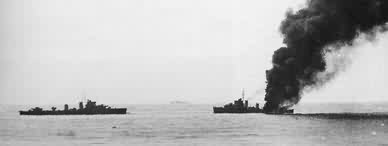 |
| We
had a very near miss from a torpedo in one of these attacks. Later
that fateful day July 23rd we were near the island of Pantelleria
and were ordered to go ahead of the convoy in company of another
destroyer to sweep for mines. We had TSDS gear (two speed destroyer
sweep) which consisted of paravanes attached to steel cables which
we streamed out aft on either side of our stern. Unfortunately,
the TSDS gear was locked in the low speed setting which reduced
our maneuverability. Soon we were involved in a high level bombing
attack and were straddled by a stick of three 500 Kilo bombs. Our good Captain Steven Norris had a reputation for "bomb dodging" but he was hampered by the TSDS gear and the middle bomb of the stick exploded in the water right alongside No1 boiler room. A large hole was blown in the starboard side of the ship and No1 boiler room flooded at once. Stoker Potty Sims was the only significant casualty as he had both his ear drums badly damaged and I thought he had probable blast damage to his lungs. Fortunately this was not the case and after 24hrs rest in the Captains bunk aft, he was all right except for profound deafness, which ended his naval career. |
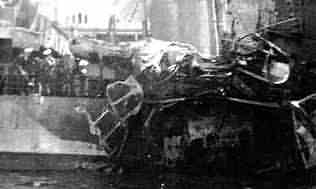 |
After
the explosion we were drifting without power, Admiral Somerville
ordered our Captain to be prepared to abandon ship. Captain Norris made back a signal to the Admiral "will have steam on one boiler in twenty minutes" so "Firedrake" was spared. Actually, it was nearly 48hrs before we had any steam to make any headway at all. A "Hunt" class destroyer the Eridge came and stood by us and then towed us for two days on the long, slow voyage back to Gibraltar. Many of us thought that the Italians would finish us off. However there was a small convoy of merchant ships |
| sailing
westward and they took the interest of the enemy. We manage to steam
the long distance back to Gib at about 7 knots. Towards the end of this epic voyage, Somerville steamed the whole of Force "H" passed us and all the ships cleared lower decks and gave us three cheers. There was "Renown", "Ark Royal" the battleship "Nelson" and several cruisers a most impressive and emotional occasion. We eventually reached dry dock in Gib and remained there for 5 or 6 weeks while initial repairs were carried out. When these repairs were complete, we were able to steam at about 12 knots but No1 boiler had to be completely rebuilt. This was to be done in Boston Navy Yard USA and so we set off in company with the cruiser "Manchester" who was destined to have damage repairs in Philadelphia. |
| We
had about 3 months in Boston, where we were generously treated by
most of the Americans. Some of the USN ratings and Irish Boston
police were a bit violent at times to some of our crew when they
were having a drink in waterfront bars, but generally the extent
of the generosity we received was unbelievable. We had so many invitations in the wardroom that the Captain allocated officers to accept this hospitality each day. We were in Boston when the Japanese bombed Pearl Harbour on December 7th 1941. There was a very pleasant Lieutenant Commander USN who was liaison officer for the RN and USN in Boston Navy Yard. |
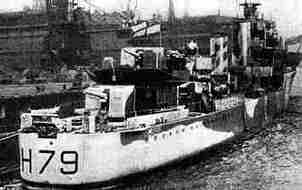 |
| He was actually on the phone to a colleague in Pearl Harbour when the bombing started and so we were some of the very first to know that the USA was joining us in the war. |
| In early January 1942 we left Boston to assume our duties and went to Halifax, Nova Scotia. Our first assignment was to accompany a 15,000 ton old Dutch Liner converted to a troopship and a large freighter called "Large Bay" of similar size. The troopship was full of young RAF personnel who had completed their flying training in the USA and Canada, the freighter was full of important stores. We had in company with us an old American 4 stacker destroyer the "Belmont". She was one of the US destroyers given to us under the "Lend Lease" agreement which Churchill had negotiated with President Roosevelt. |
| About 24 hours out of Halifax, we were in foul weather and the temperature was so low that the spray was freezing on the fo'castle, so much so that the Captain had crew members chipping the ice away in case it affected our top weight and made the ship unstable. |
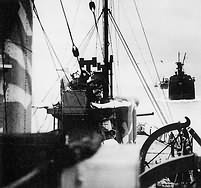 |
About
9pm on this stormy night, we saw a large orange glow where the "Belmont"
was, on the opposite side of the convoy. It was very sad as it transpired
that the "Belmont" had almost certainly been torpedoed
and we saw nothing of her or any survivors again. It was a very
worrying time as we were left alone with these two very valuable
ships, especially the troopship with her large complement of young
RAF flying personnel. I did the cyphers and we had a number of signals from the Admiralty saying "you have again been reported by U-boats, alter course at 1800 hours to 130 degrees (or whatever)". Even in 1942 we did have radar which was good enough to pick up U-boat sighting reports and the Admiralty was able to plot a DF bearing, it was known to them that we were the only convoy on that bearing. |
| By dramatic alteration of course we were soon so far south that we were in warm water and even saw some flying fish. Fortunately, our economical speed was 15 knots, the same as the two ships in our company. We eventually had to route south about Ireland instead of going through the normal Transatlantic route via the North Western Approaches. I remember doing cyphers about the location of our own minefields as the South Western Approaches were heavily defended and not normally used by us. |
|
The
Captain insisted on our two charges following us like a mother
hen with chickens through this hazardous phase of our long voyage.
We eventually got through to the Clyde and much to the relief
of our engineer officer, got alongside the oiler of Gourock, nearly
out of fuel. After this stressful voyage, it was great to feel
safe again and to know that the two valuable merchant ships were
home. We had steamed over 3,500 miles, a record for any destroyer
on one filling of fuel. We had a request to go over to the troopship
to collect a monetary gift from the grateful RAF personnel.
|
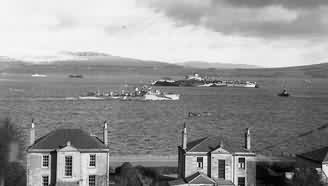 |
| They
had had a "whip round" and collected several hundred pounds,
which we gave to a fund for the dependents of the ill-fated "Belmont"'s
crew. As an afterthought, I remember that we had dropped all our depth charges on that voyage, including several "15 charge pattern", which was about 1 and a half tons of high explosive. We did think that we had sunk a U-boat at one point but could not hang around to find out. There were a number of U-boats missing at the conclusion of hostilities, which were not accounted for by either side. |
| After
the voyage from Halifax we were put on to duties as senior officer
of Transatlantic convoys B7 escort group. A typical escort force
was one destroyer in charge and 5 or 6 small "Flower Class
Corvettes". We plied between Londonderry and Argentia in Newfoundland
and luckily had no major incidents for many months. I was a bit
like a GP, General Practitioner as the only medical officer for
a convoy of 20 to 30 ships. I usually gave medical advice on a loud hailer but once I did go aboard a 10,000 ton merchant ship as the chief officer was very ill. I was taken over in one of our whalers (a large rowing boat). It was a bit tricky as I had to catch hold of a rope ladder and climb aboard, this freighter which was rolling a bit in the Atlantic swell. I remember Leading seaman Underwood who was rowing stroke saying to me "take the ladder when we are on the crest of a wave, otherwise you will get your legs broken"! |
| I
did what I could for the sick Chief Officer, including putting up
a drip of saline and put some intravenous sulpha drug into the drip.
(We had no antibiotics in those days). I am sure he had a fulminating
septicemia. Unfortunately, he died after some improvement from my
limited treatment. The Captain of the ship was very grateful to
me and insisted I use his cabin as he never left the bridge in war
time. He had a simple bunk on the bridge which all conscientious
commanders did in wartime. I lived like a king for about three days as I had the Captains cabin and pajamas, and the Captains steward! I had to stay aboard the freighter as the sea conditions were such that it was not safe to return to the "Firedrake". Most of our North Atlantic duty was uneventful but by the summer of 1942, U-boats had started to operate off the US Atlantic Coast, we took a convoy of empty tankers all the way to Curacao in the Dutch West Indies. We had 3 or 4 days when a Canadian escort group took over while we went into New York for refueling and to pick up stores. It was great to have 24hrs ashore in New York. We were tied up in Staten Island and the ferry seemed quite tame after the North Atlantic. |
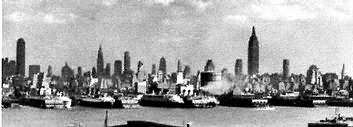 |
Photo
left is New York, where John had 24hrs ashore when Firedrake was
being refueled and stored. We then rejoined our convoy and took them all the way to Willemstad, the capital of Curacao. Curacao is a pleasant island some 25 miles off the coast of Venezuela, which was visible to the naked eye from Willemstadt. |
| It took a week to fill all our convoy of tankers with oil and then we set off on the long voyage back to the UK. The Caribbean was dead calm all the way. When things were quite, I acted as second officer on the bridge to spare some of the executive officers who had to stand watch at more exacting times. During a sultry tropical afternoon with the sea calm. I noticed a disturbance in the water ahead of us, off the port bow. As we approached the spot, it was a large baulk of timber with an equally large shark swimming round it and brushing against it, presumably to rid itself of annoying skin parasites. |
| We
were relieved by a Canadian escort group off Nova Scotia for two
days then rejoined the convoy after we had refueled. The rest of
our homeward voyage was uneventful and all the tankers got safely
home. We had no significant action or sinking's in our convoys which
we escorted from Londonderry to Argentia in Newfoundland and back.
Having served in "Firedrake" for about 18 months, I was relieved in November 1942 and it was during her next voyage that she was sunk with the loss of 168 of her crew. Naturally, I was most concerned as I knew a lot of the men who were lost and the ship herself had a personality of which we had grown very fond. |
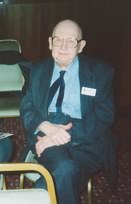 |
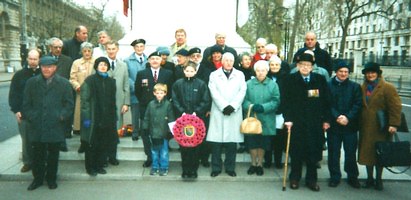 |
| The Photographs above were taken on the 16th December 2001 at the reunion of the HMS Firedrake Association. The photo left is of DR John Aldren today at the tender age of 85 years. The group photo was taken at the Cenotaph in Whitehall London after the wreath laying ceremony. |
|
They
will grow not old,
As we who are left grow old John T Aldren March 2002 |
|
Other
Pages Below
|